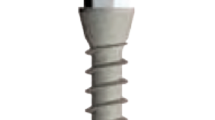Abstract
Purpose
This study aimed to evaluate the mechanical performance of mandibular implant-assisted removable partial dentures (IARPDs) on abutment teeth, supporting implants, and the mucosa. A risk assessment of patient discomfort and complications was also conducted to provide a design reference for clinical use.
Methods
Mandibular IARPDs with distal extension were analyzed using the finite element method. The mechanical performance of IARPDs was evaluated for varying numbers of missing teeth, crown-to-root ratios of abutment teeth, and locations of occlusal rests.
Results
When an implant was placed at the distal end, the peak von Mises stress in the cortical bone surrounding the abutment tooth was 14.8% lower than that when at the mesial end. Simultaneously, the peak von Mises stress was reduced by 76.7% over the mucosa and increased by 206.7% in the cortical bone surrounding the implant. The use of distal occlusal rests increased the peak von Mises stresses in the cortical bone surrounding the abutment tooth by 8.4% compared to that when using mesial occlusal rests. When the crown-to-root ratio of the abutment tooth increased from 1 to 1.5, the peak von Mises stress in the cortical bone surrounding the abutment tooth increased by 168.7%.
Conclusion
An IARPD with a distal implant can reduce the risk of post-op complications. When the crown-to-root ratio of the abutment tooth is adequate, the distal occlusal rest can be used for IARPDs of distal free ends.











Similar content being viewed by others
References
Vermeulen, A., et al. (1996). Ten-year evaluation of removable partial dentures: Survival rates based on retreatment, not wearing and replacement. The Journal of Prosthetic Dentistry, 76(3), 267–272.
Teitelbaum, S. L. (2000). Bone resorption by osteoclasts. Science, 289(5484), 1504–1508.
Keltjens, H. M., et al. (1993). Distal extension removable partial dentures supported by implants and residual teeth: Considerations and case reports. International Journal of Oral & Maxillofacial Implants, 8(2), 208–213.
De Freitas, R., et al. (2012). Mandibular implant-supported removable partial denture with distal extension: A systematic review. Journal of Oral Rehabilitation, 39(10), 791–798.
Threeburuth, W., Aunmeungtong, W., & Khongkhunthian, P. (2018). Comparison of immediate-load mini dental implants and conventional-size dental implants to retain mandibular Kennedy class I removable partial dentures: A randomized clinical trial. Clinical Implant Dentistry and Related Research, 20(5), 785–792.
Payne, A. G., et al. (2017). Multicentre prospective evaluation of implant-assisted mandibular removable partial dentures: Surgical and prosthodontic outcomes. Clinical Oral Implants Research, 28(1), 116–125.
Ohkubo, C., et al. (2007). Effect of implant support on distal extension removable partial dentures: In vitro assessment. Journal of Oral Rehabilitation, 34(1), 52–56.
Matsudate, Y., et al. (2016). Load distribution on abutment tooth, implant and residual ridge with distal-extension implant-supported removable partial denture. Journal of Prosthodontic Research, 60(4), 282–288.
Ohyama, T., et al. (2020). Mechanical analysis of the effects of implant position and abutment height on implant-assisted removable partial dentures. Journal of Prosthodontic Research, 64(3), 340–345.
Shahmiri, R., & Das, R. (2017). Finite element analysis of implant-assisted removable partial dentures: Framework design considerations. The Journal of Prosthetic Dentistry, 118(2), 177–186.
Abtan, A. A., et al. (2016). Analyzing the 3D printed material Tango plus FLX930 for using in self-folding structure. 2016 International Conference for Students on Applied Engineering (ICSAE).
Chen, F., et al. (2020). Preparation and biological evaluation of ZrO2 all-ceramic teeth by DLP technology. Ceramics International, 46(8), 11268–11274.
Ogawa, T., et al. (2004). Mapping, profiling and clustering of pressure pain threshold (PPT) in edentulous oral mucosa. Journal of Dentistry, 32(3), 219–228.
Misch, C. E. (2014). Dental implant prosthetics-e-book. Amsterdam: Elsevier Health Sciences.
Pattin, C., Caler, W., & Carter, D. (1996). Cyclic mechanical property degradation during fatigue loading of cortical bone. Journal of Biomechanics, 29(1), 69–79.
Blaber, J., et al. (2015). Ncorr: open-source 2D digital image correlation Matlab software. Experimental Mechanics, 55(6), 1105–1122.
Cendres+Métaux. Pekkton® ivory. https://www.cmsa.ch/en/medtech/products/estheticline/high-performance-polymers/pekktonr-ivory/
Stratasys. Vero Dent Plus MED690. https://www.stratasys.com/materials/search/dentalmaterials?utm_source=data-sheet&utm_medium=pdf&utm_content=dental-materials-data-sheet-link-4-verodentplus-med690
Rees, J. S., & Jacobsen, P. H. (1997). Elastic modulus of the periodontal ligament. Biomaterials, 18(14), 995–999.
Barão, V. A., et al. (2013). Comparison of different designs of implant-retained overdentures and fixed full-arch implant-supported prosthesis on stress distribution in edentulous mandible–a computed tomography-based three-dimensional finite element analysis. Journal of Biomechanics, 46(7), 1312–1320.
Acknowledgements
The authors would like to thank Professor Dr. Chih-Han Chang and for his guidance and the experimental instruments support in this research.
Funding
This work was supported by the Ministry of Science and Technology, Taiwan (Grant number 07-2221-E-006-052-MY2).
Author information
Authors and Affiliations
Corresponding author
Ethics declarations
Competing interests
The authors have no relevant financial or non-financial interests to disclose.
Rights and permissions
About this article
Cite this article
Chen, YC., Lin, CL., Yu, CH. et al. Biomechanical Analysis of Mandibular Implant-Assisted Removable Partial Denture with Distal Extension. J. Med. Biol. Eng. 42, 534–543 (2022). https://doi.org/10.1007/s40846-022-00738-z
Received:
Accepted:
Published:
Issue Date:
DOI: https://doi.org/10.1007/s40846-022-00738-z




